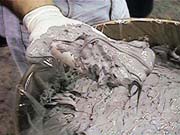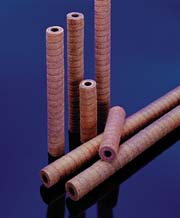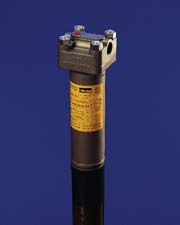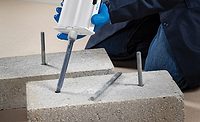The filtration of high-viscosity fluids poses one of the most difficult challenges within fluid-processing operations. In some applications, a fluid with the characteristics of 10 weight oil is considered high, but for others, it's fluids with the consistency of cold molasses. However, the differences between the two fluid types are drastically different and often represent several thousand centipoises.
In process-fluid applications, using a filtration cartridge is seldom considered a viable option for removing gelatinous particles from a fluid with a viscosity of 125,000 cPs. In the following case study, the manufacturer of a silicone sealant needed a method to re-process sealants that did not meet their quality standards.

The Problem: Waste and Costs
It's not uncommon for manufacturers of sealants to occasionally experience an upset condition within their process that results in the formation of gels within the finished bulk materials. The gel formulations are called "gel balls," and their presence leads to bridging at the opening of the nozzle of an applicator tip, which in turn causes an inconsistent bead to be applied. Gel balls also may cause plugging at the nozzle, resulting in waste and the downtime required for cleaning or premature changeout.
When presented with a process upset, the manufacturer of the sealant would simply store the drums of waste material and pay for disposal, which cost $400 a drum (see photo 1). Other processing methods were evaluated to remove the gels from this material but they weren't able to meet the quality requirements. Previously, the sealant manufacturer had tried various filtration methods, including a disc-type self-cleaning filter - allegedly designed for gel removal - and various screen-type surface media. Both failed miserably.
Analyzing the Problem
In our evaluation of this viscous filtration application, the initial investigation began with identifying the characteristics of the material and debris to be removed, which is critical to the media technology selection process. It was determined that the sealant standing viscosity was 2M centipoises and was thixotropic (shear thinning) in nature. During processing, as the material began moving within the pump and piping, it would shear thin to approximately 125,000 cPs. The gels, which are considered "soft," would extrude through surface-type filtration media once the differential pressures approached 22 psi.
Therefore, given the vast gel size distribution within this material, a tight screen with little open area would be required. In addition, a clean differential pressure of 50 psi would be required to initiate the flow through realistic applied and sized surface filter media. Therefore, media technology was not considered a viable alternative.

Applying the Depth Filtration Solution
Parker Hannifin field representatives introduced the adhesive manufacturer to the concept of depth filtration by incorporating a Parker Process Filtration Fulflo® ProBond™ phenolic resin bonded depth cartridge (see photo 2). This filter was specifically designed for gel removal and for filtration applications that require high differential pressures. It was demonstrated during the pilot testing and subsequent data acquisition that the ProBond cartridge effectively removed the unwanted gels. The previous non-usable sealant is now able to meet required specifications and quality standards.For this particular application, several tests were conducted during the pilot phase to determine extrusion, clean differential and collapse pressures, as well as flow-at-pressure characteristics for the cartridge. The extrusion pressure was required to establish the differential pressure at which the cartridge would need to be changed prior to contaminating the filtrate with passed "extruded" gels. Clean differential pressure was defined as the pressure required to induce the flow at the standing viscosity of the sealant.
Knowing that the standing viscosity was much higher than the shear thinned viscosity, the pressure required to induce flow through the cartridge would be significantly higher at the startup. It was this pressure that was used when determining feed pump pressure requirements. The collapse pressure was identified to establish a maximum allowable pressure differential and safe cartridge operating limit to avoid downstream contamination and to establish the added load factor required by the supply pump.
Details of the Test
Test results illustrated that the ProBond cartridge, with its rigid fiber matrix, did not deform or collapse under differential pressures well in excess of the published limitation of 150 psid at 70°F. Additional testing during the pilot phase determined that the tested collapse pressure of the cartridge exceeded 375 psid. The pressure required to induce standing flow through the cartridge was established at 100 psid. To avoid over-sizing the feed pump, it was decided to "slow start" the filtration process until the material reached its shear thinned viscosity, thus 100 psi was assigned as the clean differential pressure.
To determine the optimum flow rate for the system, a single 10" long ProBond™ 150µm cartridge was evaluated during the pilot phase of testing. At 125,000 cPs, a clean cartridge provided 0.9 gpm filtrate at a differential pressure starting at 100 psid and terminating at 375 psid. At completion of pilot testing, it was determined that extrusion pressure exceeded terminal change pressure; therefore, gel extrusion was no longer considered to be an issue. While the cartridge did not collapse, it was determined that at differential pressures exceeding 375 psi cartridge an end-sealing issue began to surface. However, given the volume of sealant filtered and the somewhat rapid rise from 225-375 psi at a flow constant of 0.9 gpm, it was decided to establish 225 psig as the recommended cartridge change-out pressure.

Applying a Permanent Installation
With engineering and pilot testing proven successful, the scaleup to permanent installation was the last step in providing the silicone manufacturer with a total filtration solution. The time required to accomplish the recycling task was left at the pilot flow rate of 0.9 gpm. However, to lessen operator involvement and the cleaning process between cartridge changes, media life cycle now found a position on the priority pyramid.During pilot testing of the 10" long cartridge, it was noted that the cartridge could filter between 1-2+ drums of sealant, depending upon gel load. Based on this data, it was estimated that a 30-inch-long cartridge could process approximately six drums, which met the customer's changeout target. In addition, the decision was made to install a Parker Process MSN1T1TN high-pressure single cartridge vessel (see photo 3) with a rigid support post along with one PRO150-30C ProBond cartridge. This vessel and cartridge combination would provide six drums of recycled silicone sealant at an approximate rate of one drum per/hour.
Since its installation, the MSN vessel with the ProBond cartridge has averaged in excess of the six drum/cartridge changeout. The once-unusable sealant is now finding its way onto the shelves of contractor supply and hardware stores throughout the United States.
As with many innovative process-filtration uses, success breeds new applications and investigations into reducing production costs. Presently, a silicone sealant vessel/cartridge combination is being evaluated for polishing all sealant at the point of filling. Success at this point in the process will relieve the manufacturer of double drumming, handling and storage of upset batch material, and eliminate the need and cost for future disposal.
For more information on filter cartridges, contact Parker Hannifin Corp., Process Filtration Division, 6640 Intech Blvd., Indianapolis, IN 46278; phone (317) 275-8434; fax (877) 520-5360; or e-mail rfall@parker.com.
